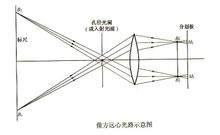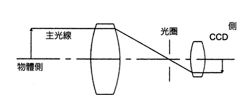Definition
Telecentric lens is mainly designed to correct the parallax of traditional industrial lenses. It can be within a certain object distance range, so that the magnification of the obtained image will not change. is a very important application. Telecentric lenses have always been favored by machine vision applications that require high lens distortion due to their unique parallel light path design.
Principle advantage
The design purpose of the editing telecentric lens is to eliminate the difference in magnification due to the inconsistency of the distance between the measured object (or CCD chip) and the lens. According to the classification and design principles of telecentric lenses, they are:
1) Design principle and function of object-side telecentric optical path:
The object-side telecentric optical path is to place the aperture diaphragm on the image-side focal plane of the optical system, and the object-side principal ray is parallel to the optical axis and the convergence center of the principal ray is located at infinity in the image side, which is called: the object-side telecentric optical path. Its function is: it can eliminate the reading error caused by the inaccurate focusing of the object side.

Object-Side Telecentric Lens Design Schematic
2) The design principle and function of the telecentric optical path of the image side:
The image-side telecentric optical path is to place the aperture diaphragm on the object-side focal plane of the optical system, and the image-side principal ray is parallel to the optical axis and the convergence center of the principal ray is located at infinity on the object side, which is called: image-side telecentric optical path. Its function is: it can eliminate the measurement error caused by inaccurate focusing on the image side.

Schematic diagram of image telecentric lens design
3) Design principle and function of telecentric optical path on both sides:
It combines the dual functions of the object-side/image-side telecentricity. Mainly used in the field of visual measurement and inspection.

Design schematic diagram of double telecentric lens
Technical parameter
1) High image resolution
Image resolution is generally measured by the CTF (Contrast Transfer Function), which quantifies the contrast between the existing spatial frequencies of the image sensor, in lp/mm (line couplings per millimeter). Most machine vision integrators tend to just aggregate a lot of cheap low-pixel, low-resolution lenses, and end up producing only blurry images. With AFT telecentric lenses, high-resolution images can be produced even with small pixel image sensors (eg 5.5 megapixels, 2/3").
2) Nearly zero distortion
The distortion factor is the percentage difference between the actual size and the image size of the image sensor. Ordinary machine lenses usually have distortion higher than 1~2%, which may seriously affect the accuracy of measurement. In contrast, the telecentric lens has passed strict manufacturing and quality inspection, and this error is strictly controlled below 0.1%.
3) No perspective error
When making precise linear measurements in metrology applications, it is often necessary to observe from the standard front of an object (completely excluding the side). In addition, many mechanical parts cannot be placed precisely, and the measurement time interval is constantly changing. Software engineers, on the other hand, need images that accurately reflect the real thing. The telecentric lens can perfectly solve the above confusion: because the entrance pupil can be located at infinity, only the chief ray parallel to the optical axis is received during imaging.
4) Telecentric design and ultra-wide depth of field
A bi-telecentric lens can not only enhance the natural depth of field with aperture and magnification, but also has an unparalleled optical effect of a non-telecentric lens: the image remains unchanged when moving objects within a certain object distance range, that is, the magnification remains unchanged.
How to choose
In recent years, machine vision has developed rapidly in China. Everyone has a certain understanding of the selection of ordinary lenses in system integration, but the selection of telecentric lenses is often confused, even with the help of technicians. I still don't know what to pay attention to when using the lens. In response to this problem, the matching principle of telecentric lens and camera is the same as that of ordinary industrial lens, as long as the size of the target surface is greater than or equal to the target surface of the camera. During use, please note that the area below the objective lens of the telecentric lens is all telecentric imaging, and the area beyond this range is not telecentric imaging in the strict sense. This must be done in actual use. Be careful, otherwise you will create unnecessary bias.
When customers choose a telecentric lens, they should first understand when they need to choose a telecentric lens. According to the principle characteristics and unique advantages of the telecentric lens, when the inspection object encounters the following 6 situations, it is best to use the telecentric lens:
1) When it is necessary to detect objects with thickness (thickness>1/10 FOV diameter);
2) When objects that are not on the same plane need to be detected;
3) When it is not clear what the distance from the object to the lens is;
4) When it is necessary to detect objects with apertures and three dimensions;
5) When low distortion is required and the brightness of the image effect is almost exactly the same;
6) When defects can only be detected under parallel illumination in the same direction.
When choosing a telecentric lens, you should first understand the corresponding usage conditions of the relevant indicators of the telecentric lens:
1) Object size ------ shooting range.
2) Image size ------ the size of the target surface of the CCD used.
3) Working distance ------ The distance between the front surface of the object-side lens and the object to be photographed.
4) Resolution --------- CCD pixel size used.
5) Depth of field------------The range where the lens can form a clear image. The larger the image/object magnification, the smaller the depth of field.
6) Interface------------ camera interface, mostly C, T and other interfaces.
Select the object lens and CCD or CMOS camera with the appropriate size of the object according to the usage (object size and required resolution), and get the image size at the same time, then you can calculate the magnification, and then select the appropriate image lens according to the product list . In the selection process, you should also pay attention to the influence of the depth of field index, because the larger the image/object magnification, the smaller the depth of field. In order to obtain a suitable depth of field, it may be necessary to re-select the lens.














